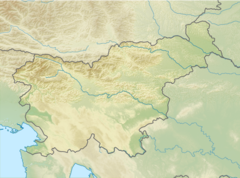Potočka zijalka | |
 Entrance to Potok Cave | |
| Location | above Solčava |
|---|---|
| Region | eastern Karawanks Slovenia |
| Coordinates | 46°26′56″N 14°40′07″E / 46.44889°N 14.66861°E |
| Type | limestone karst |
| Length | 115 m (377 ft) |
| Width | 40 m (130 ft) |
| History | |
| Material | Triassic limestone |
| Periods | Upper Paleolithic |
| Associated with | Paleo-humans |
Potok Cave [1] [2] ( Slovene: Potočka zijalka or Potočka zijavka [3]) is a cave in northern Slovenia, declared a high-elevation archaeological and paleontological site, occupied approximately 35,000 years [4] BP (before present) by anatomically modern humans of the Aurignacian culture during the Upper Paleolithic. The cave is named after the Potok Farm in Podolševa. [5] [6] The Slovene term zijalka or zijavka refers to a flat-bottomed cave with a gaping mouth on a cliff face. [6] [7] Systematic excavations were carried out from 1928 through 1935 by Slovenian archaeologist Srečko Brodar. [8]
Location
The cave is located in the eastern Karawanks in northern Slovenia, on the southern slope of Mount Olševa above Solčava, at an elevation of 1,675 m (5,495 ft) in the Triassic limestone. [8] It is 115 m (377 ft) [9] long and varies from 17 m (56 ft) wide at the mouth to 40 m (130 ft) wide in the interior. [9] Its entry opens toward the south. [8]
Role
There are two explanations of its role. According to the original explanation, the cave was a hunting station. According to the newer one, it was a ritual place. [8]
Excavations
After amateur excavations by Josef Gross, a medical student from Austria, the area was bought by the Museum Society of Celje. Systematic excavations were carried out on its behalf by archaeologist Srečko Brodar, starting in 1928 [10] and continuing until 1935. [9]
The finds from eight layers excavated from the cave included the bones of more than 40 animal species, including cave bears, wolves, alpine marmots, hares, red foxes, weasels, lynx, red deer, and chamois, and muskox teeth, as well as 123 arrowheads and one of the world's oldest sewing needles. [8] [11]
Exhibits
In a village near the cave, a permanent exhibit is open for tourists at the Firšt Inn and Museum in the Logar Valley. [12] The other finds can be seen at the Celje Regional Museum. Unfortunately much of the collection was destroyed during World War II in 1945 Allied bombing raids. [9]
Gallery
-
Inside Potok Cave
-
Inside Potok Cave
See also
References
- ^ Snodgrass, Mary Ellen. 2014. World Clothing and Fashion: An Encyclopedia of History, Culture, and Social Influence. New York: Routledge, p. 207.
- ^ Dowson, Thomas. 2013. "Views from Ancient Doorways," Archaeology Travel.
- ^ Bezlaj, France. 1961. Slovenska vodna imena, vol. 2. Ljubljana: SAZU, p. 337.
- ^ "Potočka zijavka". Parc.si. Palaeolithic Research Centre. Archived from the original on 2012-10-03.
- ^ Mišič, Franc. 1938. "O ledinskih in hišnih imenih okoli Solčave." Časopis za zgodovino in narodopisje 33(3/4): 191–201, p. 195.
- ^ a b SlovLit: Potočka zijalka (in Slovene)
- ^ Bezlaj, France et al. 2005. Etimološki slovar slovenskega jezika vol. 4. Ljubljana: SAZU, p. 411.
- ^ a b c d e Debeljak, Irena; Turk, Matija. "Potočka zijalka". In Šmid Hribar, Mateja; Torkar, Gregor; Golež, Mateja; et al. (eds.). Enciklopedija naravne in kulturne dediščine na Slovenskem – DEDI (in Slovenian). Archived from the original on 15 May 2012. Retrieved 12 March 2012.
- ^ a b c d Broda, Mitja. 1995. "Potočka zijalka." Enciklopedija Slovenije, vol. 9, Ljubljana: Mladinska knjiga, pp. 193–194.
- ^ Brodar, Srečko, & Mitja Brodar. 1983. Potočka zijalka, visokoalpska postaja aurignacienskih lovcev. Ljubljana: SAZU, p. 12.
- ^ Odar, Boštjan (2008). "A Dufour Bladelet from Potočka zijalka (Slovenia)" (PDF). Arheološki vestnik. 59: 13.
- ^ Stalna razstava Potočka zijalka (Potok Cave Permanent Exhibit) (in Slovene)
External links
-
 Media related to
Potok Cave at Wikimedia Commons
Media related to
Potok Cave at Wikimedia Commons




